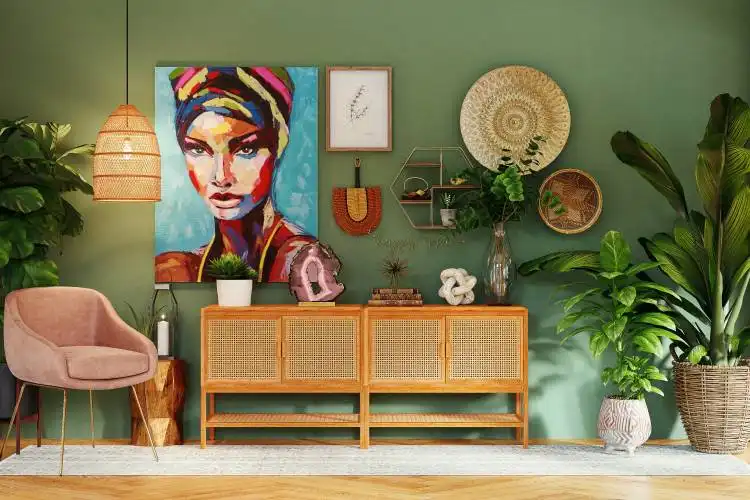Start a Home Decorator Business
Turning a Passion for Design Into Your Dream Business
| Updated


HOME DECORATOR BUSINESS
Ever dream of transforming empty spaces into breathtaking environments? Your passion could turn into a flourishing home decorator business! This venture offers services ranging from advising on color palettes and fabrics, to choosing furniture and artwork, making every client's abode a visual delight. Remember, pencils are sharpened, creativity is fuelled, and potential customers are just one well-placed throw pillow away in the captivating world of home decoration!
Jump to Business Plan
RELATED BUSINESS IDEAS
Browse ALL Home Improvement & Repair Solutions Business Ideas
Discover Your Perfect Domain
Unlock the door to your online success with our hand-picked selection of premium domain names. Whether you're starting a new venture or rebranding an existing one, the right domain can set the tone for your digital presence. Browse through our curated list, each with its unique potential to enhance your brand's visibility and credibility.
HOME DECORATOR MINI BUSINESS PLAN
This a quick reality check to help you identify the strengths and weaknesses of your business concept before you dive in.
Expected Percent Margins:
- Gross Margin: 35-45%
- Net Profit Margin: 15-25%
Earnings Expectations:
- Daily Earnings: $100 - $300
- Weekly Earnings: $700 - $2,100
- Monthly Earnings: $3,000 - $9,000
- Annual Earnings: $36,000 - $108,000
Actions to Hit Those Numbers:
Project Management:
- Initial Investment: Budget approximately $10,000 - $15,000 for initial startup expenses including license, insurance, software, and office setup.
- Project Pipeline: Target to have at least 2-3 ongoing projects and 5-7 consultations per month.
Marketing and Customer Acquisition:
- Social Media: Post daily design inspiration and project updates on platforms like Instagram and Pinterest.
- Networking: Attend home shows, local events, and collaborate with local businesses.
- Word of Mouth: Encourage referrals by offering discounts or incentives.
Service Offering and Pricing:
- Pricing: Price services based on the project size, complexity and estimated hours involved. Ensure prices cover your costs, overheads and desired profit margins.
- Diversify Offerings: Offer a range of services including full-room makeovers, color consultations, shopping services, e-design, etc.
Cost Control:
- Supplies: Establish trade accounts with wholesalers for accessing furniture, textiles, art, etc., at discounted prices.
- Operational Expenses: Remote working or co-working spaces can save on office rental expenses.
Business Operations:
- Work Hours: As a service-based business, flexibility in working hour is important. Meetings and consultations might take place during evenings or weekends to accommodate client's schedules.
- Relationship Building: Develop good relationships with suppliers, contractors, and especially clients. Happy, satisfied customers can fuel your business via word-of-mouth.
These are generalized estimations and can vary depending on location, economic conditions, and individual business strategies. Always consult with a financial advisor for personalized advice.
NOT WHAT YOU HAD IN MIND? Here are more ideas



Browse ALL Home Improvement & Repair Solutions Business Ideas
Grab Your Business Website Name
Before you get caught up in the whirlwind of setting up your business, invest in a domain name. It's a small but significant step that lays the foundation for your brand and makes it easier for customers to find and trust you. Just like you wouldn't build a house without securing the land first, don't build a business without securing your domain name.
"Why? Can't that wait?" Here's why it shouldn't
Step 1: Determine if the Business is Right for You
Breakdown of Startup Expenses
When starting a home decorator business, it is important to understand the startup costs involved. This includes the cost of any materials you will need to purchase, such as paint, fabric, furniture, and other decor items. You will also need to consider the cost of any tools or equipment you will need, such as a sewing machine, a ladder, or a paint sprayer. Additionally, you may need to pay for any licenses or permits required to start a business in your area. Finally, you should factor in the cost of any marketing materials you will need to promote your business.
Breakdown of Ongoing Expenses
Once you have established your business, there will be ongoing expenses to consider. These include the cost of any materials you will need to purchase on a regular basis, such as paint, fabric, furniture, and other decor items. You will also need to budget for any tools or equipment you will need to maintain your business, such as a sewing machine, a ladder, or a paint sprayer. Additionally, you may need to pay for any licenses or permits required to keep your business running. Finally, you should factor in the cost of any marketing materials you will need to continue promoting your business.
Examples of Ways to Make Money
Once you have established your business, there are a number of ways to make money. You can offer services such as interior design, home staging, furniture selection, and color consultation. You can also offer products such as furniture, artwork, and accessories. Additionally, you can offer classes or workshops on topics such as home decorating, furniture selection, and color theory. Finally, you can offer online services such as virtual consultations, e-design services, and online classes.
Step 2: Name the Business
When it comes to naming a business, it is important to choose a name that reflects the values and mission of the business. It should be easy to remember and should stand out from other businesses in the same field. It is also important to consider the potential for trademarking the name, as well as the availability of domain names and social media handles. Additionally, it is important to consider the potential for the name to be mispronounced or misunderstood.
When brainstorming potential names, it is helpful to consider the services offered, the target market, and the overall mission of the business. It is also important to consider the potential for the name to be used in marketing and advertising materials. Additionally, it is important to consider the potential for the name to be used in legal documents and contracts.
Once a name has been chosen, it is important to research the availability of the name. This includes researching the availability of domain names, social media handles, and trademarks. Additionally, it is important to research the potential for the name to be mispronounced or misunderstood.
When registering the business, it is important to register the name with the appropriate government agency. This will ensure that the business is legally recognized and that the name is legally protected. Additionally, it is important to register the name with the appropriate domain registrar and social media platforms.
Finally, it is important to create a logo and branding materials that reflect the name and mission of the business. This will help to create a recognizable and memorable brand that will help to attract customers and build a loyal customer base.
Step 3: Create a Business Plan
Creating a business plan is essential for any business. It will help you determine the best way to move forward and will provide a roadmap for success. When creating a business plan, there are several components to consider.
The first component is the executive summary. This should provide an overview of the business, its goals, and the strategies you plan to use to reach those goals. It should also include a brief description of the products or services you plan to offer.
The second component is a market analysis. This should include research into the current home decorator market, the potential customer base, and any competitors. It should also include an analysis of the current trends in the industry and how they may affect your business.
The third component is a financial plan. This should include an estimate of startup costs, ongoing expenses, and projected income. It should also include a plan for financing the business, such as taking out a loan or seeking investors.
The fourth component is a marketing plan. This should include a description of the products or services you plan to offer, as well as a plan for how you will market them. It should also include a plan for how you will reach potential customers and how you will differentiate your business from competitors.
The fifth component is an operations plan. This should include a description of the day-to-day operations of the business, such as how you will manage inventory and how you will handle customer service. It should also include a plan for how you will manage employees, if applicable.
The sixth component is a risk management plan. This should include an analysis of potential risks the business may face and a plan for how to mitigate those risks.
Finally, the seventh component is an exit strategy. This should include a plan for how you will exit the business if necessary, such as selling the business or transitioning to a new owner.
Creating a comprehensive business plan is essential for any business, and it is especially important for a home decorator business. It will provide a roadmap for success and help you make informed decisions about how to move forward.
Step 4: Register the Business
In order to register the business, there are certain requirements that must be met. Depending on the state, these requirements may vary. Generally, the business must be registered with the state, county, and/or city. This may include obtaining a business license, registering the business name, and paying any necessary fees. Additionally, the business may need to register with the IRS and obtain an Employer Identification Number (EIN). It is important to research the specific requirements for registering a business in the state where the business will be located.
Choosing a Business Structure
When registering a business, it is important to choose the right business structure. The most common business structures are sole proprietorship, partnership, limited liability company (LLC), and corporation. Each structure has its own advantages and disadvantages. For example, a sole proprietorship is the easiest and least expensive to set up, but it does not provide any personal liability protection. On the other hand, a corporation is more complex and expensive to set up, but it does provide personal liability protection. It is important to research the different business structures and choose the one that best fits the business needs.
Obtaining Necessary Insurance
When starting a home decorator business, it is important to obtain the necessary insurance. This may include general liability insurance, property insurance, and workers’ compensation insurance. General liability insurance protects the business from claims of bodily injury and property damage. Property insurance protects the business from losses due to theft, fire, and other disasters. Workers’ compensation insurance provides coverage for employees in the event of a work-related injury or illness. It is important to research the different types of insurance and obtain the necessary coverage.
Step 5: Obtain Necessary Licenses and Permits
Before starting a home decorator business, it is important to research and obtain the necessary licenses and permits for the state and local government. Depending on the state, the types of licenses and permits needed may vary. For example, in some states, a business license is required to operate a business. Additionally, a seller's permit may be necessary in order to purchase items for resale. Other permits may include zoning permits, health permits, and fire permits.
How to Obtain Licenses and Permits
The process for obtaining the necessary licenses and permits for a home decorator business can vary depending on the state and local government. Generally, the process involves submitting an application and paying a fee. The application will require information such as the business name, address, and type of business. Additionally, the business owner may need to provide proof of insurance, a business plan, and other documents. After submitting the application, the business owner will need to wait for approval before they can begin operating their business.
Costs of Licenses and Permits
The costs of obtaining licenses and permits for a home decorator business can vary depending on the state and local government. Generally, the cost of licenses and permits will include an application fee, a registration fee, and a fee for any additional permits. Additionally, the business owner may need to pay for insurance and other fees. It is important to research the cost of licenses and permits before starting a business in order to ensure that the business can afford the necessary fees.
Benefits of Obtaining Licenses and Permits
Obtaining the necessary licenses and permits for a home decorator business is important for a number of reasons. First, it ensures that the business is operating legally. Additionally, it can help protect the business from potential legal issues. Finally, it can help the business gain credibility with customers and potential customers.
Step 6: Set Up a Business Bank Account
Having a business bank account is an important step in setting up a home decorator business. It helps to separate personal and business finances, making it easier to track expenses and income. It also makes it easier to apply for business loans and other financing. Additionally, having a business bank account can help to establish credibility with customers and vendors.
How to Set Up a Business Bank Account
Setting up a business bank account is relatively simple. First, you will need to provide the bank with your business name, address, and contact information. You will also need to provide proof of your business registration, such as a business license or an Employer Identification Number (EIN). You may also need to provide a copy of your business plan and financial projections. Once you have all of the necessary documents, you can open the account and start using it to manage your business finances.
Tips for Choosing a Bank
When choosing a bank for your business, it is important to consider the fees and services offered. Look for a bank that offers competitive rates and fees, as well as services that are tailored to the needs of your business. You should also make sure that the bank has a good reputation and is FDIC-insured. Additionally, it is important to make sure that the bank has good customer service, as you will likely need to contact them with questions or concerns.
Step 7: Market the Business
Once the business is up and running, it is important to market it to potential customers. Examples of marketing strategies include creating a website, participating in local events, and utilizing social media platforms. Additionally, it is important to create a logo and branding for the business. This will help customers recognize the business and create a sense of trust. Additionally, creating a newsletter or email list can be beneficial to keep customers informed about new products or services.
Advertising
Advertising is also an important part of marketing the business. Advertising can be done through print, radio, or television. Additionally, advertising can be done online through search engine optimization (SEO), pay-per-click (PPC) campaigns, and social media campaigns. It is important to research the different types of advertising to determine which will be the most effective for the business. Additionally, it is important to create a budget for advertising and stick to it.
Networking
Networking is also an important part of marketing the business. Networking can be done through attending local events, joining professional organizations, and attending trade shows. Additionally, networking can be done online through social media platforms and professional websites. Networking can help the business gain exposure and create relationships with potential customers.
Word of Mouth
Word of mouth is also an important part of marketing the business. Encouraging customers to leave reviews and share their experiences with the business can help to spread the word about the business. Additionally, offering incentives such as discounts or free services can help to encourage customers to spread the word about the business.
Step 8: Set Up a Home Office
Setting up a home office is an important part of starting a home decorator business. It is important to create a comfortable, organized, and professional workspace to ensure success. Here are some tips to help you set up your home office:
- Choose a space that is comfortable and free from distractions. It should be a space that is conducive to productivity and creativity.
- Invest in the right office furniture and equipment. This includes a desk, chair, filing cabinet, computer, printer, and other necessary items.
- Make sure the space is well-lit and has adequate storage. This will help you stay organized and efficient.
- Decorate the space with items that inspire you and make you feel motivated.
- Set up a filing system to keep track of important documents and paperwork.
- Establish a routine and stick to it. This will help you stay on track and be productive.
Step 9: Market Your Business
Tips on Marketing Your Business
Marketing your home decorator business is an important step in ensuring success. Here are some tips to help you market your business:
- Create a website and social media accounts to showcase your work and services.
- Develop a portfolio of your work and use it to promote your business.
- Reach out to potential clients and let them know about your services.
- Network with other home decorators and professionals in the industry.
- Participate in local events and trade shows to get your name out there.
- Offer discounts and promotions to attract new customers.
- Utilize online advertising platforms such as Google Ads and Facebook Ads.
- Create content such as blog posts, videos, and podcasts to engage with potential customers.
Step 9: Stay Up to Date on Trends
Staying up to date on trends is essential for any business, but especially for a home decorator business. One of the best ways to stay informed is to follow industry-specific blogs and websites. This will help you stay informed on the latest design trends and help you stay ahead of the competition. Additionally, attending trade shows and conferences can be a great way to network and learn about the latest trends in the industry.
Another great way to stay informed is to follow the work of other home decorators. This can be done by following their work on social media or subscribing to their newsletters. This will help you stay informed on the latest trends and help you stay ahead of the competition.
Finally, reading industry magazines and books can be a great way to stay informed on the latest trends. This will help you stay informed on the latest design trends and help you stay ahead of the competition. Additionally, it can be a great way to get inspired and come up with new ideas for your business.
Overall, staying up to date on trends is essential for any home decorator business. By following industry-specific blogs and websites, attending trade shows and conferences, following the work of other home decorators, and reading industry magazines and books, you can stay informed on the latest trends and help you stay ahead of the competition.
EXPLORE MORE CATEGORIES
Browse ALL Business Idea Categories
TAKE THE NEXT STEPS









